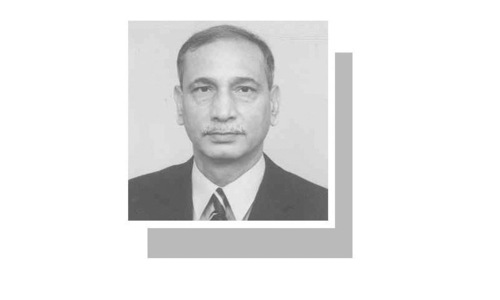KHATIR Ghaznavi (1925-2008), the well-known poet and scholar from Khyber Pakhtunkhwa, had surmised that the origin of the Urdu language lay in the Hindko language.
Urdu’s origin is an issue that has kicked up many controversies, claims, counterclaims, rejoinders and arguments among scholars. Several regions — such as Punjab, Sindh, Deccan, Delhi and Multan, Bihar — and several languages — such as Punjabi, Brij Bhasha, Khari Boli, Pali Prakrit, Seraiki and Delhi dialects — have claims of having given birth to Urdu.
Though the issue has remained a bone of contention for quite long and a large number of books and research papers have been written on the topic favouring different theories, over the past few decades, the issue has inched up towards sort of a consensus and many scholars now almost agree with the idea that suggests that Urdu was born of the dialects spoken in and around Delhi, especially Khari Boli. However, it has not stopped scholars from presenting new theories about Urdu’s origin, or, simply, the theory of Delhi dialects is not acceptable to some.
One theory proffered about a decade ago said that Hindko had given birth to Urdu. Khatir Ghaznavi’s book Urdu zaban ka makhaz Hindko, or the Urdu language’s source Hindko, (National Language Authority, Islamabad, 2003) tried to establish the idea that Urdu’s origin and source was the Hindko language, though the theory was not new and before Khatir Ghaznavi, some scholars of Hindko, such as Mukhtar Ali Nayyar and Farigh Bukhari, had expressed the similar views in their writings. Khatir Ghaznavi was of the view that an ancient language of the Indus valley developed into Hindko and gave birth to both Urdu and Hindi.
Hindko, an Indo-Aryan language, is the widely spoken in Khyber Pakhtunkhwa and some parts of Punjab. The Hindko language is generally considered a dialect of western Punjabi, which is also known as Lehnda, but the native speakers of Hindko generally do not agree with the notion and insist that Hindko is a separate, distinct language.
Dr Arshad Mahmood Nashaad in his Atraaf-e-tehqeeq (Al-Fath Publications, Rawalpindi, 2012) has written that there are millions of native speakers of Hindko in Hazara division and the districts of Peshawar, Kohat, Bannu and Dera Ismail Khan. Dr Nashaad has divided the Hindko language into four major dialects: Hazara waali, which is influenced by Pahari and Potohari dialects; Peshawari accent, which is influenced by Persian; Kohati Hindko, which has effects of Pashto and Punjabi’s Ghaibi dialect; and Dera waali, the one spoken in and around Dera Ismail Khan and which is quite different from other dialects of Hindko.
Dr Nashaad does not agree with Khatir Ghaznavi on the issue of the areas where Hindko is spoken. He feels that Ghaznavi Sahib had extended the geographical boundaries of the native speakers of Hindko quite unduly to include some parts of Sindh and Baluchistan as well. Nashaad feels that the Hindko language should not be seen in isolation as it is the language of the ancient people who lived on the banks of the river Indus. These people were also called Hindko. Khatir Ghaznavi was a poet, lyricist, columnist, editor, educationist, translator, critic, dramatist, linguist, prose-writer, broadcaster and research scholar. He participated in the activities of the NWFP chapter of the Progressive Writers’ Association. In his life he had remained associated with different newspapers and magazines as well and edited at least a dozen of them. Khatir Ghaznavi had a knack for learning languages and he knew Urdu, Pashto, Hindko, English, Persian, Chinese, Malay and Russian.
Born in 1925 in Peshawar, Khatir Ghaznavi’s real name was Muhammad Ibrahim Baig. In 1958 when he did MA (Urdu) with flying colours from Peshawar University, he was offered lecturer’s post at the Urdu department of the university. But he was already working with Radio Pakistan. Later, he quit Radio and joined the Urdu department of Peshawar University in 1962. In 1965, he went to China on a scholarship and obtained a diploma in the Chinese language.
On his return he established the Chinese language centre at Peshawar University and was asked to teach at Urdu department as well. From time to time, between 1967 and 1981, he taught Urdu at Peshawar University. Finally, his services were given to Urdu department where he was made the head of department in 1984. He was made the Chairman of Pakistan Academy of Letters (PAL) the same year, but after a while he quit and left for Malaysia where he taught Urdu and Pakistan Studies for about four years.
He has to his credit over 50 books in Urdu, Pashto and Hindko. Some of his works are Phool aur patther (novella), Sarhad ke rooman, Pashto matloona (Pashto proverbs), Dastar nama (Urdu translation of Khushhaal Khan Khattak’s prose work), Khwaab dar khwaab (collection of poetry), Khushhaal nama, Jadeed Urdu adab (criticism), Zindagi ke liye (play), Wuthering heights (dramatisation), Koonjaan (Hindko ghazals), Dictionary of common words in Urdu and Bhasha Malaysia and Roop rang (songs).
Khatir Ghaznavi died in a Karachi hospital on July 7, 2008, and was buried in Peshawar the next day.
Published in Dawn, July 6th, 2015
On a mobile phone? Get the Dawn Mobile App: Apple Store | Google Play














































Dear visitor, the comments section is undergoing an overhaul and will return soon.